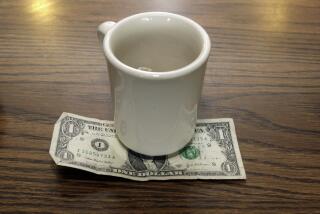Low-Wage Workers Are Seeking to Tip the Scales With Gratuity Cups
- Share via
PHILADELPHIA — Standing smack on top of the cash register between Seman Fedil and his customers is a battered plastic foam cup he personalized with his name and a hopeful hint: “Tips.”
Although they’re common in trendy coffee shops, a tip cup seems somewhat out of place in this downtown Dunkin’ Donuts, part of a chain whose uniformed workers have been dishing out doughnuts and java to take-out customers for 50 years.
“I was surprised to see the tip cups,” said Toni Ogle, reluctantly tossing in a quarter before leaving with her coffee. “What do they do to get a tip? They’re waiting on you. They’re getting paid for it.”
With Pavlovian reflex, customers are dumping money into tip containers left and right these days, leaving coffee shops, ice cream parlors and greasy sandwich joints to cash in on a growing trend that preys on pity.
“It doesn’t take a genius to figure out that if you put a cup out someone will put a tip in it. It’s begging,” said Christopher Muller, an assistant professor in Cornell University’s School of Hotel Administration.
“Why do we tip people for doing their job well?” Muller asked. “Do you leave $10 in an envelope for the garbage guys at Christmas? Does it mean that they’ll toss the garbage on the lawn if you don’t?”
Tip cups seem to be popping up in minimum-wage retail establishments that seldom solicited gratuities until recently.
“I have noticed that as a new phenomenon in the last five years--saw it in the West Coast and here in the Rocky Mountain region--coffee houses and other kinds of delis, small outlets that don’t have table service have these tipping jars,” said Kim Long, who documents annual trends in the American Forecaster Almanac, published in Denver.
“If this is spreading, it ought to spread outside of coffee shops, and therefore at some movie theater somewhere in the U.S., someone’s going to put a tip jar on the counter next to the popcorn machine,” Long said.
Long speculates that the tip cup phenomenon is rooted in the growth of gourmet coffee shops, which invite tips by showering customers with smiles and specializing in hard-to-make coffee concoctions.
Seattle-based Starbucks is at the forefront of the coffee shop phenomenon, boasting more than 960 stores nationwide and aiming for 2,000 worldwide by the end of the millennium, spokeswoman Jeanne McKay said.
Unlike many retail food and beverage establishments, Starbucks pays part- and full-time workers starting wages of $6 to $7 an hour and offers them generous benefits and stock packages.
Even so, tip cups abound. The company allows workers to display 4-by-4-inch unmarked Plexiglas cups by its registers.
“We try to be subtle,” she said. “We don’t want to shove it down customers’ throats and make them feel like they have to tip.”
At Dunkin’ Donuts, individual store owners decide whether employees can display tip cups as a way of boosting morale, said Jennifer Rosenberg, spokeswoman for the Randolph, Mass., company.
The mere presence of the tip cup, however unobtrusive, can be psychologically potent.
“It’s an intimidation strategy. You put a cup out and people feel like they have to put money in it, and they don’t know why,” said Cornell’s Muller.
Take Marie Raggio. Moments after being handed change for a cup of hazelnut-flavored coffee, Raggio flipped her right wrist over the Starbucks tip cup, opened her hand and let loose a fistful of coins.
“I should have a reason for giving my money away--especially as an accountant for a law firm,” Raggio said, smiling as she searched for an explanation. “Maybe it’s because I see the cup there.”
Jamie Rubin, 20, knows the benefits of a well-placed tip cup. As a part-time worker at Ashley’s Ice Cream in New Haven, Conn., the college student has taken home as much as $30 in tips on a good night.
“It’s real important, because we only get paid $5 an hour,” said Rubin, who attends Southern Connecticut University. “It really makes a difference.”
More to Read
Sign up for Essential California
The most important California stories and recommendations in your inbox every morning.
You may occasionally receive promotional content from the Los Angeles Times.












